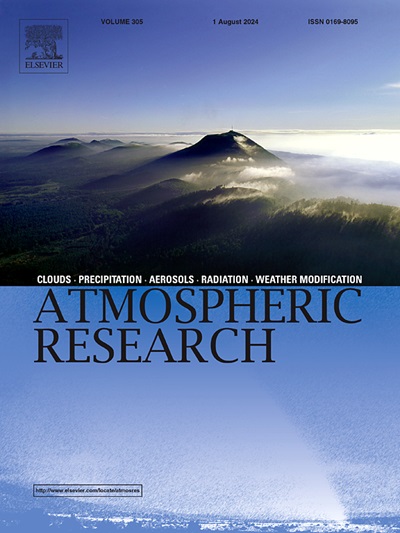Lightning nowcasting based on high-density area and extrapolation utilizing long-range lightning location data
IF 4.5
2区 地球科学
Q1 METEOROLOGY & ATMOSPHERIC SCIENCES
引用次数: 0
Abstract
Lightning poses varying degrees of threat to human production, life and personal safety because of its huge destructive power. Lightning prediction with intensity estimation is an important reference for disaster warning, determining lightning protection level and real-time and dynamic lightning risk assessment. Real-time observation of total lightning can compensate for the problem of limited range or shielding of radar observation and is of great significance for thunderstorm tracking and lightning nowcasting. In this paper, the VLF Lightning Location Network (VLF-LLN) is used to obtain real-time long-range lightning location data. Through density estimation based on the Gaussian mixture model and weighted according to time proximity, the spatio-temporal range and frequency information of lightning high-density area are obtained. Then, a spatio-temporal data extrapolation model ME-RNN is proposed to predict the intensity of lightning activity and its evolution pattern in the thunderstorm region, so as to realize the nowcasting of lightning activity. Based on the PredRNN architecture, the model integrates the MotionGRU operator optimized for the characteristics of lightning data, and integrates the generative adversative network (GAN) to capture the transient changes of lightning phenomena and predict its movement trend. At 6 min, 18 min and 36 min before the thunderstorm reached the area of concentration (AOC), the prediction accuracy of the model was 94.1 %, 79.4 % and 65.8 %, respectively. Furthermore, the ME-RNN model can track the active thunderstorm cells associated with lightning activity, and realize the prediction of the separation and merging of lightning high-density area, as well as the prediction of moving trend.
求助全文
约1分钟内获得全文
求助全文
来源期刊

Atmospheric Research
地学-气象与大气科学
CiteScore
9.40
自引率
10.90%
发文量
460
审稿时长
47 days
期刊介绍:
The journal publishes scientific papers (research papers, review articles, letters and notes) dealing with the part of the atmosphere where meteorological events occur. Attention is given to all processes extending from the earth surface to the tropopause, but special emphasis continues to be devoted to the physics of clouds, mesoscale meteorology and air pollution, i.e. atmospheric aerosols; microphysical processes; cloud dynamics and thermodynamics; numerical simulation, climatology, climate change and weather modification.
 求助内容:
求助内容: 应助结果提醒方式:
应助结果提醒方式:


